实验2
1.实验任务1
T.h源码
点击查看代码
#pragma once
#include <string>
// 类T: 声明
class T {
// 对象属性、方法
public:
T(int x = 0, int y = 0); // 普通构造函数
T(const T &t); // 复制构造函数
T(T &&t); // 移动构造函数
~T(); // 析构函数
void adjust(int ratio); // 按系数成倍调整数据
void display() const; // 以(m1, m2)形式显示T类对象信息
private:
int m1, m2;
// 类属性、方法
public:
static int get_cnt(); // 显示当前T类对象总数
public:
static const std::string doc; // 类T的描述信息
static const int max_cnt; // 类T对象上限
private:
static int cnt; // 当前T类对象数目
// 类T友元函数声明
friend void func();
};
// 普通函数声明
void func();
点击查看代码
#include "T.h"
#include <iostream>
#include <string>
// 类T实现
// static成员数据类外初始化
const std::string T::doc{"a simple class sample"};
const int T::max_cnt = 999;
int T::cnt = 0;
// 类方法
int T::get_cnt() {
return cnt;
}
// 对象方法
T::T(int x, int y): m1{x}, m2{y} {
++cnt;
std::cout << "T constructor called.\n";
}
T::T(const T &t): m1{t.m1}, m2{t.m2} {
++cnt;
std::cout << "T copy constructor called.\n";
}
T::T(T &&t): m1{t.m1}, m2{t.m2} {
++cnt;
std::cout << "T move constructor called.\n";
}
T::~T() {
--cnt;
std::cout << "T destructor called.\n";
}
void T::adjust(int ratio) {
m1 *= ratio;
m2 *= ratio;
}
void T::display() const {
std::cout << "(" << m1 << ", " << m2 << ")" ;
}
// 普通函数实现
void func() {
T t5(42);
t5.m2 = 2049;
std::cout << "t5 = "; t5.display(); std::cout << '\n';
}
点击查看代码
#include "T.h"
#include <iostream>
void test_T();
int main() {
std::cout << "test Class T: \n";
test_T();
std::cout << "\ntest friend func: \n";
func();
}
void test_T() {
using std::cout;
using std::endl;
cout << "T info: " << T::doc << endl;
cout << "T objects'max count: " << T::max_cnt << endl;
cout << "T objects'current count: " << T::get_cnt() << endl << endl;
T t1;
cout << "t1 = "; t1.display(); cout << endl;
T t2(3, 4);
cout << "t2 = "; t2.display(); cout << endl;
T t3(t2);
t3.adjust(2);
cout << "t3 = "; t3.display(); cout << endl;
T t4(std::move(t2));
cout << "t4 = "; t4.display(); cout << endl;
cout << "test: T objects'current count: " << T::get_cnt() << endl;
}
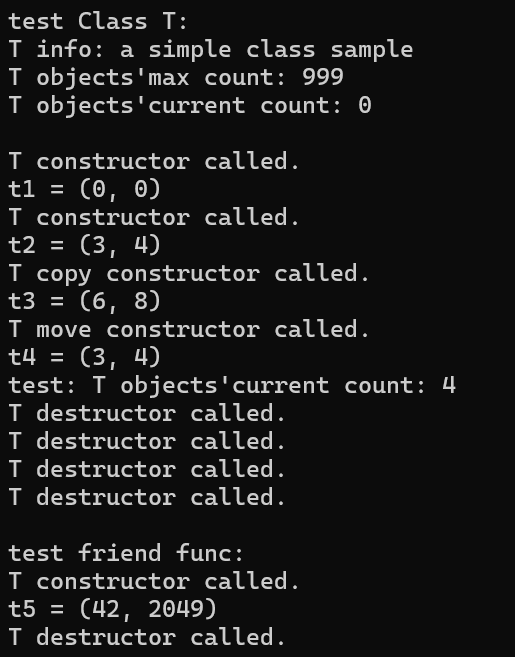
问题1:
T.h中,在类T内部,已声明 func 是T的友元函数。在类外部,去掉line36,重新编译,程序能否正常运行。
如果能,回答YES;如果不能,以截图形式提供编译报错信息,说明原因。
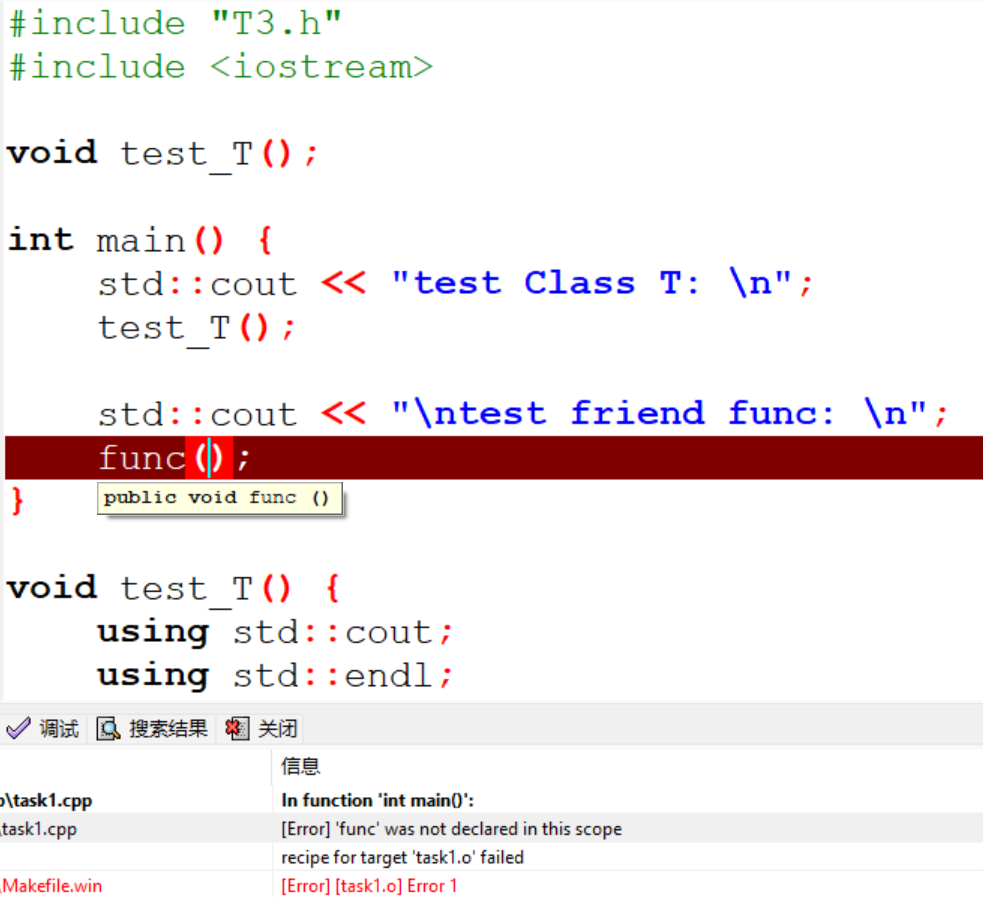
回答:编译时报错,提示func未声明。因为在类内部声明友元函数仅表示该函数可以访问类的私有成员,但函数的声明仍需在类外部或头文件中给出,否则编译器无法识别该函数。
问题2:
T.h中,line9-12给出了各种构造函数、析构函数。总结它们各自的功能、调用时机。
回答:普通构造函数:初始化对象,为对象分配资源并设置初始状态。当使用T t(3,4)等方式创建对象时调用。
复制构造函数:用已有对象初始化新对象,实现对象的拷贝。当使用T t3(t2)创建对象时调用。
移动构造函数:转移已有对象的资源,避免深拷贝。当将对象转为右值引用,用于初始化新对象时调用。
析构函数:销毁对象,释放对象占用的资源。当对象的生命周期结束时自动调用。
问题3:
T.cpp中,line13-15,剪切到T.h的末尾,重新编译,程序能否正确编译。如不能,以截图形式给出报错信息,分析原因。

回答:将T.cpp的定义剪切到T.h末尾,在多文件编译时,多个.cpp文件调用头文件会出现函数重复定义的错误。
2.实验任务2
Complex.h源码
点击查看代码
#pragma once
#include <string>
#include <cmath>
class Complex {
public:
static const std::string doc; // 类说明
private:
double real; // 实部
double imag; // 虚部
public:
// 构造函数
Complex(double r = 0.0, double i = 0.0) : real(r), imag(i) {}
Complex(const Complex &other) : real(other.real), imag(other.imag) {} // 复制构造
// 接口
double get_real() const { return real; }
double get_imag() const { return imag; }
void add(const Complex &other) {
real += other.real;
imag += other.imag;
}
// 友元函数
friend void output(const Complex &c);
friend double abs(const Complex &c);
friend Complex add(const Complex &c1, const Complex &c2);
friend bool is_equal(const Complex &c1, const Complex &c2);
friend bool is_not_equal(const Complex &c1, const Complex &c2);
};
点击查看代码
#include "Complex.h"
#include <iostream>
const std::string Complex::doc = "a simplified complex class";
void output(const Complex &c) {
if (c.imag >= 0) {
std::cout << c.real << " + " << c.imag << "i";
} else {
std::cout << c.real << " - " << -c.imag << "i";
}
}
double abs(const Complex &c) {
return std::sqrt(c.real * c.real + c.imag * c.imag);
}
Complex add(const Complex &c1, const Complex &c2) {
return Complex(c1.real + c2.real, c1.imag + c2.imag);
}
bool is_equal(const Complex &c1, const Complex &c2) {
return c1.real == c2.real && c1.imag == c2.imag;
}
bool is_not_equal(const Complex &c1, const Complex &c2) {
return !is_equal(c1, c2);
}
点击查看代码
#include "Complex.h"
#include <iostream>
#include <iomanip>
#include <complex>
void test_Complex();
void test_std_complex();
int main() {
std::cout << "*******测试1: 自定义类Complex*******\n";
test_Complex();
std::cout << "\n*******测试2: 标准库模板类complex*******\n";
test_std_complex();
}
void test_Complex() {
using std::cout;
using std::endl;
using std::boolalpha;
cout << "类成员测试: " << endl;
cout << Complex::doc << endl << endl;
cout << "Complex对象测试: " << endl;
Complex c1;
Complex c2(3, -4);
Complex c3(c2);
Complex c4 = c2;
const Complex c5(3.5);
cout << "c1 = "; output(c1); cout << endl;
cout << "c2 = "; output(c2); cout << endl;
cout << "c3 = "; output(c3); cout << endl;
cout << "c4 = "; output(c4); cout << endl;
cout << "c5.real = " << c5.get_real()
<< ", c5.imag = " << c5.get_imag() << endl << endl;
cout << "复数运算测试: " << endl;
cout << "abs(c2) = " << abs(c2) << endl;
c1.add(c2);
cout << "c1 += c2, c1 = "; output(c1); cout << endl;
cout << boolalpha;
cout << "c1 == c2 : " << is_equal(c1, c2) << endl;
cout << "c1 != c2 : " << is_not_equal(c1, c2) << endl;
c4 = add(c2, c3);
cout << "c4 = c2 + c3, c4 = "; output(c4); cout << endl;
}
void test_std_complex() {
using std::cout;
using std::endl;
using std::boolalpha;
cout << "std::complex<double>对象测试: " << endl;
std::complex<double> c1;
std::complex<double> c2(3, -4);
std::complex<double> c3(c2);
std::complex<double> c4 = c2;
const std::complex<double> c5(3.5);
cout << "c1 = " << c1 << endl;
cout << "c2 = " << c2 << endl;
cout << "c3 = " << c3 << endl;
cout << "c4 = " << c4 << endl;
cout << "c5.real = " << c5.real()
<< ", c5.imag = " << c5.imag() << endl << endl;
cout << "复数运算测试: " << endl;
cout << "abs(c2) = " << abs(c2) << endl;
c1 += c2;
cout << "c1 += c2, c1 = " << c1 << endl;
cout << boolalpha;
cout << "c1 == c2 : " << (c1 == c2)<< endl;
cout << "c1 != c2 : " << (c1 != c2) << endl;
c4 = c2 + c3;
cout << "c4 = c2 + c3, c4 = " << c4 << endl;
}
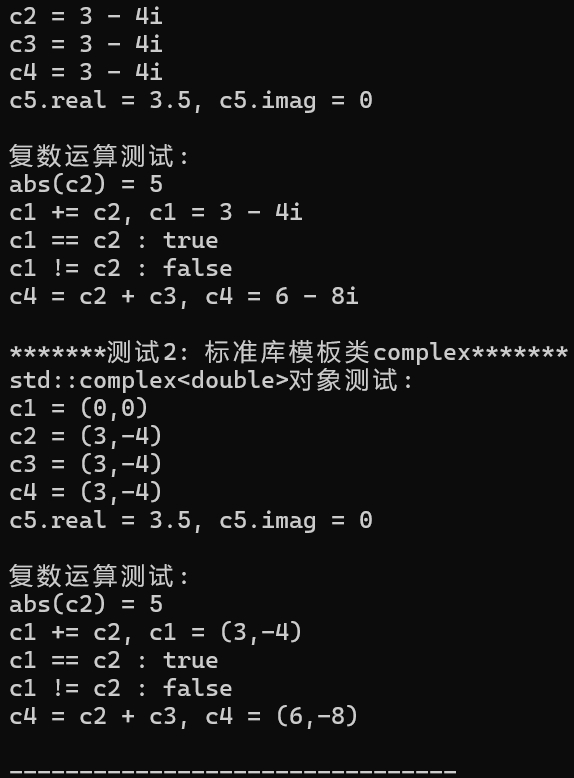
问题1:
比较自定义类 Complex 和标准库模板类 complex 的用法,在使用形式上,哪一种更简洁?函数和运算内在有关联吗?
回答:标准库模板类complex更简洁。标准库通过运算符重载(如+=、+、==等),更贴近数学运算的自然形式;而自定义类通过成员函数和友元函数实现,形式更复杂。函数和运算内在是关联的,都是为了实现复数的各类操作,只是形式不同。
问题2:
2-1:自定义 Complex 中, output/abs/add/ 等均设为友元,它们真的需要访问 私有数据吗?
回答:不需要。虽然output需要访问实部和虚部来格式化输出,abs需要实部和虚部计算模长,add需要访问两个复数的实部和虚部来计算和,但是可以根据公共接口get_real()和get_imag()来获取实部和虚部。
2-2:标准库 std::complex 是否把 abs 设为友元?
回答:否。标准库std::complex的abs函数是通过公共接口real()和imag()来获取实部和虚部的,不需要友元权限。
2-3:什么时候才考虑使用 friend?总结你的思考。
回答:当外部函数需要访问类的私有成员,且这些函数与类有紧密的逻辑关联,同时又不适合作为类的成员函数时,考虑使用friend。
问题3:
如果构造对象时禁用=形式,即遇到 Complex c4 = c2; 编译报错,类Complex的设计应如何调整?
回答:可以删除复制构造函数,声明Complex(const Complex& other) = delete;。
3.实验任务3
PlayerControl.h源码
点击查看代码
#pragma once
#include <string>
enum class ControlType { Play, Pause, Next, Prev, Stop, Unknown };
class PlayerControl {
public:
PlayerControl();
ControlType parse(const std::string& control_str);
void execute(ControlType cmd) const;
static int get_cnt();
private:
static int total_cnt;
};
点击查看代码
#include "PlayerControl.h"
#include <iostream>
#include <algorithm>
int PlayerControl::total_cnt = 0;
PlayerControl::PlayerControl() {}
ControlType PlayerControl::parse(const std::string& control_str) {
std::string lower_str = control_str;
std::transform(lower_str.begin(), lower_str.end(), lower_str.begin(), ::tolower);
if (lower_str == "play") {
total_cnt++;
return ControlType::Play;
} else if (lower_str == "pause") {
total_cnt++;
return ControlType::Pause;
} else if (lower_str == "next") {
total_cnt++;
return ControlType::Next;
} else if (lower_str == "prev") {
total_cnt++;
return ControlType::Prev;
} else if (lower_str == "stop") {
total_cnt++;
return ControlType::Stop;
} else {
return ControlType::Unknown;
}
}
void PlayerControl::execute(ControlType cmd) const {
switch (cmd) {
case ControlType::Play: std::cout << "[play] Playing music...\n"; break;
case ControlType::Pause: std::cout << "[Pause] Music paused\n"; break;
case ControlType::Next: std::cout << "[Next] Skipping to next track\n"; break;
case ControlType::Prev: std::cout << "[Prev] Back to previous track\n"; break;
case ControlType::Stop: std::cout << "[Stop] Music stopped\n"; break;
default: std::cout << "[Error] unknown control\n"; break;
}
}
int PlayerControl::get_cnt() {
return total_cnt;
}
点击查看代码
#include "PlayerControl.h"
#include <iostream>
void test() {
PlayerControl controller;
std::string control_str;
std::cout << "Enter Control: (play/pause/next/prev/stop/quit):\n";
while (std::cin >> control_str) {
if (control_str == "quit") break;
ControlType cmd = controller.parse(control_str);
controller.execute(cmd);
std::cout << "Current Player control: " << PlayerControl::get_cnt() << "\n\n";
}
}
int main() {
test();
return 0;
}
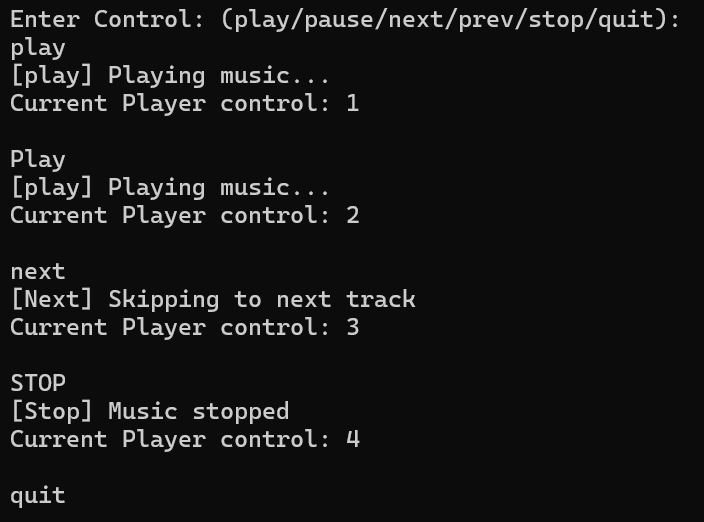
4.实验任务4
Fraction.h源码
点击查看代码
#ifndef FRACTION_H
#define FRACTION_H
#include <string>
class Fraction {
private:
int up;
int down;
void reduce();
int gcd(int a, int b);
public:
static const std::string doc;
Fraction(int u = 0, int d = 1);
Fraction(const Fraction& other); // 拷贝构造
int get_up() const;
int get_down() const;
Fraction negative() const;
// 友元工具函数
friend void output(const Fraction& f);
friend Fraction add(const Fraction& f1, const Fraction& f2);
friend Fraction sub(const Fraction& f1, const Fraction& f2);
friend Fraction mul(const Fraction& f1, const Fraction& f2);
friend Fraction div(const Fraction& f1, const Fraction& f2);
};
#endif
点击查看代码
#include "Fraction1.h"
#include <iostream>
#include <cstdlib>
const std::string Fraction::doc = "Fraction类 v0.01版.\n目前仅支持分数对象的构造、输出、加/减/乘/除运算.";
Fraction::Fraction(int u, int d) : up(u), down(d) {
if (down == 0) {
std::cerr << "分母不能为0" << std::endl;
exit(1);
}
reduce();
}
Fraction::Fraction(const Fraction& other) : up(other.up), down(other.down) {}
int Fraction::gcd(int a, int b) {
a = std::abs(a);
b = std::abs(b);
while (b != 0) {
int temp = b;
b = a % b;
a = temp;
}
return a;
}
void Fraction::reduce() {
if (down < 0) {
up = -up;
down = -down;
}
int g = gcd(up, down);
if (g != 0) {
up /= g;
down /= g;
}
}
int Fraction::get_up() const { return up; }
int Fraction::get_down() const { return down; }
Fraction Fraction::negative() const {
return Fraction(-up, down);
}
void output(const Fraction& f) {
if (f.down == 1) {
std::cout << f.up;
} else {
std::cout << f.up << "/" << f.down;
}
}
Fraction add(const Fraction& f1, const Fraction& f2) {
int u = f1.up * f2.down + f2.up * f1.down;
int d = f1.down * f2.down;
Fraction res(u, d);
res.reduce();
return res;
}
Fraction sub(const Fraction& f1, const Fraction& f2) {
int u = f1.up * f2.down - f2.up * f1.down;
int d = f1.down * f2.down;
Fraction res(u, d);
res.reduce();
return res;
}
Fraction mul(const Fraction& f1, const Fraction& f2) {
int u = f1.up * f2.up;
int d = f1.down * f2.down;
Fraction res(u, d);
res.reduce();
return res;
}
Fraction div(const Fraction& f1, const Fraction& f2) {
if (f2.up == 0) {
std::cerr << "除数不能为0" << std::endl;
exit(1);
}
int u = f1.up * f2.down;
int d = f1.down * f2.up;
Fraction res(u, d);
res.reduce();
return res;
}
点击查看代码
#include "Fraction1.h"
#include <iostream>
void test1();
void test2();
int main() {
std::cout << "测试1:Fraction类基础功能测试\n";
test1();
std::cout << "\n测试2:分母为0测试:\n";
test2();
return 0;
}
void test1() {
using std::cout;
using std::endl;
cout << "Fraction类测试:" << endl;
cout << Fraction::doc << endl << endl;
Fraction f1(5);
Fraction f2(3, -4), f3(-18, 12);
Fraction f4(f3);
cout << "f1 = "; output(f1); cout << endl;
cout << "f2 = "; output(f2); cout << endl;
cout << "f3 = "; output(f3); cout << endl;
cout << "f4 = "; output(f4); cout << endl;
const Fraction f5(f4.negative());
cout << "f5 = "; output(f5); cout << endl;
cout << "f5.get_up() = " << f5.get_up()
<< ", f5.get_down() = " << f5.get_down() << endl;
cout << "f1 + f2 = "; output(add(f1, f2)); cout << endl;
cout << "f1 - f2 = "; output(sub(f1, f2)); cout << endl;
cout << "f1 * f2 = "; output(mul(f1, f2)); cout << endl;
cout << "f1 / f2 = "; output(div(f1, f2)); cout << endl;
cout << "f4 + f5 = "; output(add(f4, f5)); cout << endl;
}
void test2() {
using std::cout;
using std::endl;
Fraction f6(42, 55), f7(0, 3);
cout << "f6 = "; output(f6); cout << endl;
cout << "f7 = "; output(f7); cout << endl;
cout << "f6 / f7 = ";
try {
output(div(f6, f7));
} catch (...) {
cout << "分母不能为0";
}
cout << endl;
}
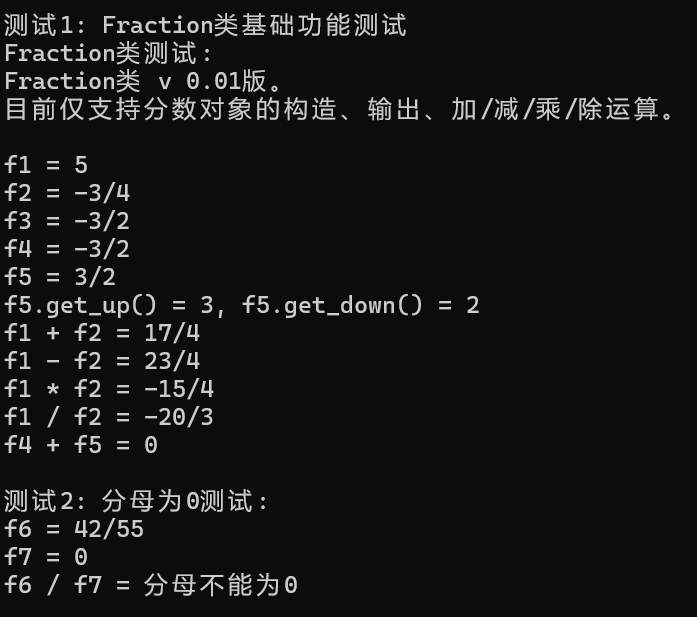
分数的输出和计算, output/add/sub/mul/div ,你选择的是哪一种设计方案?(友元/自由函数/命名空间+自由函数/类+static)
你的决策理由?如友元方案的优缺点、静态成员函数方案的适用场景、命名空间方案的考虑因素等。
回答:选择友元函数实现output、add、sub、mul、div的原因的是:友元函数可以直接访问Fraction类的私有成员(up和down),避免了频繁调用getter,同时函数接口更简洁。相比自由函数,友元函数不要频繁调用getter;相比静态成员函数,友元函数的调用方式更接近普通的函数式运算,更加方便。
实验总结
实验任务1的第1、3问,最初我通过理论分析,认为是会报错的,但是在修改编辑后,正常运行出结果。这和我的分析结果不同,我的分析过程如下:
(1)从原理分析,通过查相关资料,我分析出理论上是会编译错报的;
(2)分析是否是devc++的问题,之前我遇到过一些问题是由devc++和其他编译器不同导致的,所以我怀疑可能是devc++导致的。通过参考同学博客的报错信息,devc++是可以报这个错的;
(3)分析是否是文件的问题,联想到之前我在实验中遇到过文件名称混合导致的出乎意料的问题,我先将T.h里代码全部删去,发现仍能正常编译运行出结果,所以我推测是电脑里不同位置有多个T.h文件,导致了之前的问题。
解决方法:
对于实验任务1的第1、3问的修改,建立两个新项目,项目中用T2.h,T3.h等作为区分,得到的报错与理论预期相同。



 浙公网安备 33010602011771号
浙公网安备 33010602011771号